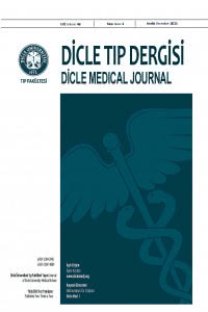Yttrium-90 radioembolization for the treatment of unresectable liver cancer: Results of a single center
Rezeke edilemeyen karaciğer tümörlerinde yttrium-90 radyoembolizan tedavi: Tek merkez sonuçları
___
- 1. Jaffe BM, Donegan WL, Watson F, et al. Factors influencing the survival in patients with untreated hepatic metastases. Surg Gynec Obstet 1968;127:1-11.
- 2. Bengmark S, Hafström, L. The natural history of primary and secondary malignant tumors of the liver. The prognosis for patients with hepatic metastases from colonic and rectal carcinoma by laparotomy. Cancer 1969;23:198-202.
- 3. Marrero JA, Fontana RJ, Barrat A, et al. Prognosis of Hepatocellular Carcinoma: Comparison of 7 Staging Systems in an American Cohort. Hepatology 2005;42:707-716. 4. Garreana S, Espat NJ. Yttrium-90 internal radiation therapy for hepatic malignancy. Surgical Oncology 2005;14:179- 193.
- 5. Ariel IM. Treatment of inoperable primary pancreatic and liver cancer by the intra-arterial administration of radioactive isotopes (Y90 radiating microspheres). Ann Surgery 1965;162:267-278.
- 6. Grindlay JH, Herrick JF, Mann FC. Measurement of the blood flow of the liver. Am J Physiol 1941; 132: 489-496.
- 7. Dawson LA, Normolle D, Balter JM, McGinn CJ, Lawrence TS, Ten Haken RK. Analysis of radiation induced liver disease using the Lyman NTCP model. Int J Radiat Oncol Biol Phys 2002;53:810821.
- 8. Herfarth KK, Debus J, Lohr F, et al. Stereotactic single dose radiation therapy of liver tumors: Results of a phase I/II trial. J Clin Oncol 2001;19:64-170.
- 9. Breedis C, Young G. The blood supply of neoplasms in the liver. Am J Pathol 1954;30:969-984.
- 10. Therasse P, Arbuck SG, Eisenhauer EA, et al. New Guidelines to valuate the Response to Treatment in Solid Tumors. J National Cancer Inst 2000;92:205-216.
- 11. Sato KT, Lewandowski RJ, Mulcahy MF, et al. Unresectable Chemorefractory Liver Metastases: Radioembolization with 90Y Microspheres Safety, Efficacy and Survival. Radiology 2008;247:507-515.
- 12. Peynircioglu B, Cil B, Bozkurt F, Aydemir E, Ugur O, Balkancı F. Radioembolization for the treatment of unresectable liver cancer: initial experience at a single center. Diagn Interv Radiol 2010;16:70-78.
- 13. Garrean S, Espat NJ. Yttrium-90 internal radiation therapy for hepatic malignancy. Surgical Oncology 2005;14:179- 193.
- 14. Gray BN, Burton MA, Kelleher D, et al. Tolerance of the liver to the effects of Yttrium-90 radiation. Int J Radiat Oncol Biol Phys 1990;18:619-623.
- 15. Sato KT, Lewandowski RJ, Mulcahy MF, et al. Unresectable chemorefractory liver metastases: Radioembolization with Y90 microspheres safety, efficacy, and survival. Radiology 2008;247:507-515.
- 16. Hendlisz A, Van den Eynde M, Peeters MPhase III Trial Comparing Protracted Intravenous Fluorouracil Infusion Alone or With Yttrium-90 Resin Microspheres Radioembolization for Liver-Limited Metastatic Colorectal Cancer Refractory to Standard Chemotherapy. J Clin Oncol 2010;28:3687-3694.
- 17. Sharma RA, Van Hazel GA, Morgan B. Radioembolization of Liver Metastases From Colorectal Cancer Using Yttrium-90 Microspheres With Concomitant Systemic Oxaliplatin, Fluorouracil,and Leucovorin Chemotherapy. J Clin Oncol 2007;25:1099-1106.
- 18. Vente F, Wondergem M, Van der Tweel I, et al. Yttrium-90 microsphere radioembolization for the treatment of liver malignancies: a structured meta-analysis. Eur Radiol 2009;19:951-959.
- 19. Coldwell DM, Kennedy AS, Nutting CW. Use of yttrium-90 microspheres in the treatment of unresectable hepatic metastases from breast cancer. Int J Radiat Oncol Biol Phys 2007;69:800-804.
- 20. Jakobs TF, Hoffmann RT, Fischer T, et al. Radioembolization in patients with hepatic metastases from breast cancer. J Vasc Interv Radiol 2008;19:683-690.
- 21. Cianni R, Urigo C, Notarianni E, et al. Radioembolisation using yttrium 90 (Y-90) in patients affected by unresectable hepatic metastases. Radiol med 2010;115:619-633.
- ISSN: 1300-2945
- Yayın Aralığı: 4
- Başlangıç: 1963
- Yayıncı: Cahfer GÜLOĞLU
Sezai ÇELİK, Bülent AYDEMİR, Oya UNCU, Tamer OKAY, Muharrem ÇELİK
Emel TORUN, Türkay SARITAŞ, Feyza KAHRAMAN USTABAŞ, Nurcan OSMANOĞLU KESKİN, Faruk ÖKTEM
Transrektal prostat iğne biyopsisi sonrası gelişen üriner sistem infeksiyonları deneyimlerimiz
Gülay DEDE, İrfan ŞENCAN, ONUR DEDE, Gönül ŞENTÜRK, Aslı HAYKIR
Evaluation of protein and lipid oxidative stress in the patients with postmenopausal osteoporosis
Banu ÇAVDAROĞLU, Nurgül KÖSE, Gülden BAŞKOL, Hüseyin DEMİR
Anesthesia experience along with familial Mediterranean fever and celiac disease
Mehmet SARGIN, Hale BORAZAN, Gülçin HACIBEYOĞLU, Şeref OTELCİOĞLU
Major alt ekstremite cerrahisinde anestezi türünün postoperatif komplikasyonlara etkisi
Murat BAKIŞ, SİNEM SARI ÖZTÜRK, Ayhan Öznur CİLLİMOĞLU, Özgür ÖZBEY, Bakiye UĞUR, MUSTAFA OĞURLU
Baran GENCER, Fahri GÜNEŞ, Yusuf Ziya TAN, Erdem AKBAL, Hasan Ali TUFAN, Yeliz EKİM, Hacer ŞEN, Arzu Taşkıran ÇÖMEZ, Semra ÖZDEMİR, Selçuk KARA
The effect of varicocele on the right testicular blood flow in patients with left varicocele
OKTAY ÜÇER, Serdar TARHAN, M. Oğuz ŞAHİN, Bilal GÜMÜŞ
Dua Sümeyra DEMİRKIRAN, Adnan ÇELİKEL, Cem ZEREN, Muhammet Mustafa ARSLAN
